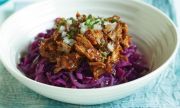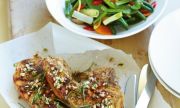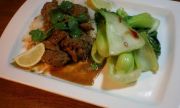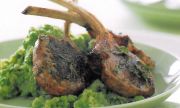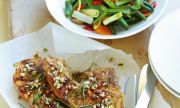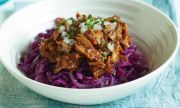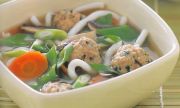It is important to make sure you match the cooking method to the cut of meat that you are cooking. We've matched the different cuts to the cooking methods below.
Breaking News
The big news is that after 7 years of all the fun of running My Farm Shop, we are shutting up shop after delivery of the 2019 Christmas Hams.
Thank you to all the customers who have supported us to help spread the word about regenerative and sustainable production practices. We are very proud of you all and the fact that you choose to use your purchasing power to support farmers that are doing the right thing.
You'll still see or hear of us around the world of Regenerative Agriculture, as we're putting our energies into some exciting new projects in that space.
Roasting Pork
Recommended cuts: Leg, Shoulder (fore quarter), Rolled Loin, Rolled Belly, Rack
- Preheat the oven to the recommended temperature
- Remove the meat from the cryovac bag and allow it to come to room temperature (20 minutes out of the fridge, under a tea towel)
- For crackling:
- Score the rind at 1cm intervals (the roasts from My Farm Shop are already scored)
- Rub roast lightly with oil and salt, and place on a rack in a roasting tray or on a base of carrots and potatoes (helps brown evenly)
- Cook at 220°C for 20 minutes, and then reduce oven to 180°C and cook for 20 minutes per 500g
- Without crackling:
- Sear roast in pan until skin is lightly browned
- Place on a rack in a roasting tray or on a base of carrots and potatoes (helps brown evenly)
- Cook at 180°C for 20 minutes per 500g
- Check internal temperature with a meat thermometer periodically (don't just wait until the anticipated cooking time is up)
- Once cooked, remove from oven and rest for 10 minutes (covered with foil on a warmed plate)
- Carve across the grain of the meat
To keep the pork roast nice and juicy, cook it to medium - which will have n internal temperature of 65-70°C.
An additional crackling tip - some wise folks out there also pour boiling water over the skin after scoring the rind. They pat it dry, then apply the oil and salt. Let us know how you go and if you've got any other sure fire tips for a great crackling.
Pan Fry / Grill / BBQ Pork
Recommended cuts: Loin chops, Cutlets, Fillet, Scotch steak, Spare Ribs, Mince, Sausages
- Remove the meat from the cryovac bag and allow it to come to room temperature (10 minutes out of the fridge, under a tea towel)
- Coat the meat in oil instead of adding oil to the pan/bbq/hotplate (this can help reduce the amount of oil used)
- Cook over a medium heat to avoid drying out the meat
- Chops, Cutlets and Fillet: 3-4 minutes each side
- Spare Ribs: 7-10 minutes each side
- Sausages and mince burgers - 4-6 minutes per side until cooked throughout
- After cooking, rest meat on a warmed plate (covered with foil) for 2-4 minutes (except for sausages and mince).
Stir Frying Pork
Recommended cuts: Fillet, Loin, Leg, Diced
- Remove the meat from the cryovac bag and allow it to come to room temperature (10 minutes out of the fridge, under a tea towel)
- Cut into even size pieces 10mm thick, cutting across the grain of the meat.
- Brush the meat in oil instead of adding oil to the pan (this can help reduce the amount of oil used)
- Ensure the cooking surface is hot - the meat should sizzle, but the oil should not smoke (too hot)
- Cook the meat in small batches (200g at a time) to make sure the pan stays hot and to stop the meat from stewing.
- Set the cooked meat aside while you cook all the other items (spices, vegetables, and sauce)
- Lower the heat, and return the meat to the pan with the rest of the stir fry. Combine but do not allow to boil (as this will stew and toughen the meat).
- Serve immediately.
Slow Cooking Pork
Recommended cuts: Shoulder (forequarter), leg cuts, Hocks, Shanks, Ribs
- Remove the meat from the cryovac bag and allow it to come to room temperature (10 minutes out of the fridge, under a tea towel)
- Cut into 2cm thick cubes
- Brush the meat in oil instead of adding oil to the pan (this can help reduce the amount of oil used)
- Brown the meat in small batches in a pan (200g at a time). This seals in the juices. Set aside.
- Lower the heat, add onions, aromatics (garlic, spices) and saute.
- Add vegetables, stock, and beef, bring to the boil and then reduce heat to low.
- Cover and simmer for approximately 2 hours (alternatively, place in 160°C oven for 2 hours).
- Natural fats and oils main settle on top of the dish during cooking - these can be scooped off as desired.
